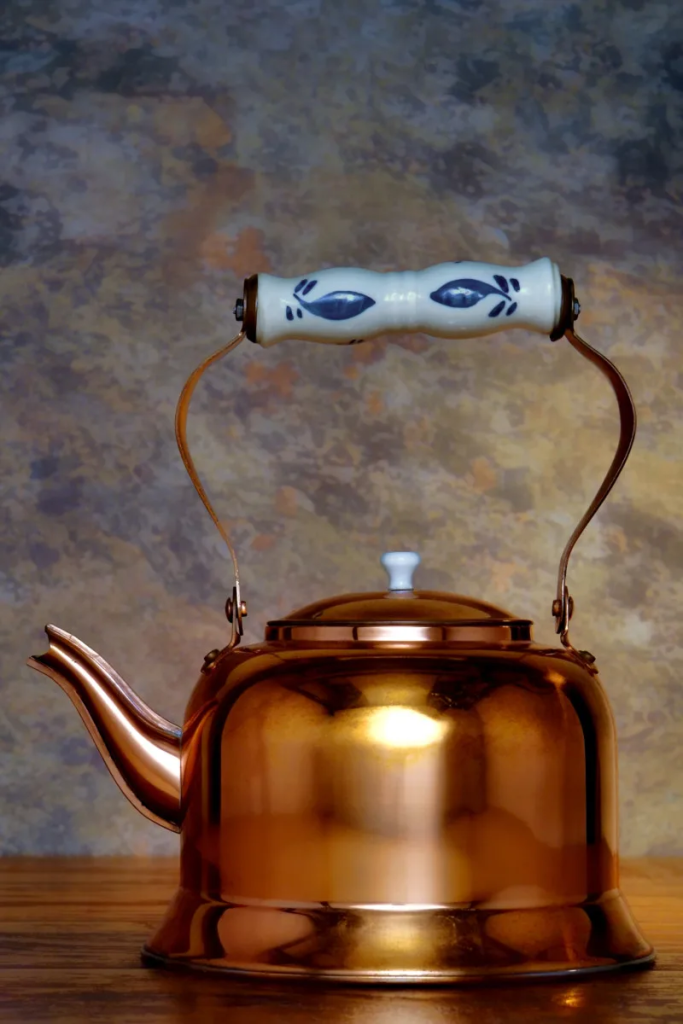Copper is a familiar metal.
It has such a beautiful, warm glow and charm. It’s also Julie Andrews’ favorite, because it’s a bright copper kettle.

The bright copper kettle is inspired by the bright copper kettle and creates a homey and cozy atmosphere.
Now I need to make a tea garden so I can blend my own herbal teas.
But what if copper is not so shiny these days? What if your beloved pots and kettles are getting very worn out?
No need to use harsh chemicals.
We have a few items in your pantry and elbow grease to make them come alive and shine. If you’re not a fan of using elbow grease, let me share with you the easiest copper cleaning secret of all. (It’s crazy, you’ll be surprised when you try it).
Before we get started, there are a few things you need to know about copper. Copper is a particularly soft metal and scratches easily. Never use abrasive cleaners or scrubbing brushes. Even a gentle blue scrubber can scratch unpainted copper.
If copper needs to be “scrubbed,” cut a lemon in half, sprinkle the cut end generously with salt, and scrub with the salt.
If you find a clean antique that you intend to clean, but the discoloration is very dark, you may not be able to restore the original color of the copper.
Copper will develop a beautiful luster over the years and become just as attractive as the beautiful orange color it started out with.
Sealers and coatings
Some pieces are sealed with lacquer to make the copper more durable and less prone to discoloration. Cleaning copper with acids such as vinegar or lemon juice can remove or damage this coating.
How to tell if copper is sealed
If the copper is not dark, shiny, and dusty, the piece is lacquered. Uncoated copper has a soft, warm glow and will darken in color over time.

You can see the difference between lacquered and un-lacquered in these two photos.
You can see that this copper pot has a dull shine because it is not lacquered.

Lacquered copper can be brought back to shine with soap and water and a light sponge.
If you have unlacquered copper, please read on. It will restore a warm glow.
White Vinegar and Salt

This copper plate can be modified a little or a lot.
This is the quickest and most effective way to clean copper.
Place 3 cups of water: 1 cup of vinegar: 1 tablespoon of salt in a saucepan and heat. Bring to a boil and add the copper pieces. Bring to a boil for about 60 seconds. This is all it takes to remove the gunk.

If it is just boiling, this will improve it considerably.
Remove and rinse with water. If it still needs some tlc, dab with salt lemon and a soft cloth.

All you need at this point is a little elbow grease.
If the copper pieces are too large to boil, mix 1 cup of vinegar and 1 tablespoon of salt and soak the copper pieces in the mixture. Turn it frequently to cover the entire copper piece. After the copper piece has been soaked to remove any tarnish, rinse it under cold water and allow it to dry.
When the copper is as clean as you want it to be (or if you are about to clean it), wipe it down with a chamois skin or flannel.
Here is a picture of the front and back side by side….

Do you like to use ketchup?
One of my favorite ways to clean copper is the easiest way. All you need is ketchup. Yes, that is correct. Last time I showed you how to remove copper oxidation with acid.

Ketchup? Yes, ketchup.
If you have ever made ketchup, you know that ketchup contains vinegar. This is necessary to remove the discoloration caused by oxidation.

Don’t soak your fries in it, though.
The beauty of using ketchup is that it is in paste form. It is easy to apply it to what you want to clean and leave it on. Let it sit for at least 30 minutes and the vinegar will take care of everything.

I found this old Revere vessel at a thrift store and decided to spruce it up a bit. You can see how the previous owner scrubbed the bottom too hard and scratched it.
My mother taught me this when I was a child.
When I was given the task of polishing a copper-bottomed pot, I would use ketchup to draw smiley faces and short texts on the bottom of the pot, while leaving the rest of the pot unpolished. Needless to say, she didn’t find it funny when she looked at the bottom of her favorite pot and saw the word “poop” written in shiny copper.
Well, I did think it was funny.
To keep the copper shiny: .
Copper oxidizes quickly, so even if you polish it to a shiny finish, it won’t stay that way for long.

Newly polished hammered copper.
If you want to keep it looking presentable, but don’t want the hassle of cleaning it regularly, a thin coat of linseed oil or carnauba wax will protect the metal from the oxidizing effects of air.
When it comes to high-end copper cookware, it’s recommended to avoid any coating and embrace the metal’s natural state. A little copper smell is more unique anyway. You can also teach your kids how to wash copper with ketchup and see what interesting things stick to pots and pans.

Perhaps the beauty and charm of copper is in the patina it develops over time.
Perhaps the beauty and charm of copper lies in the patina it develops over the years.” Give me your tired, your poop ……”










